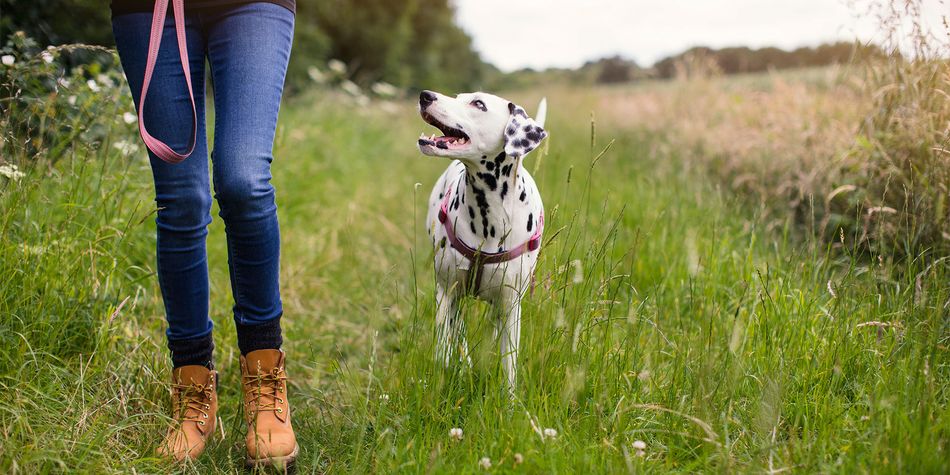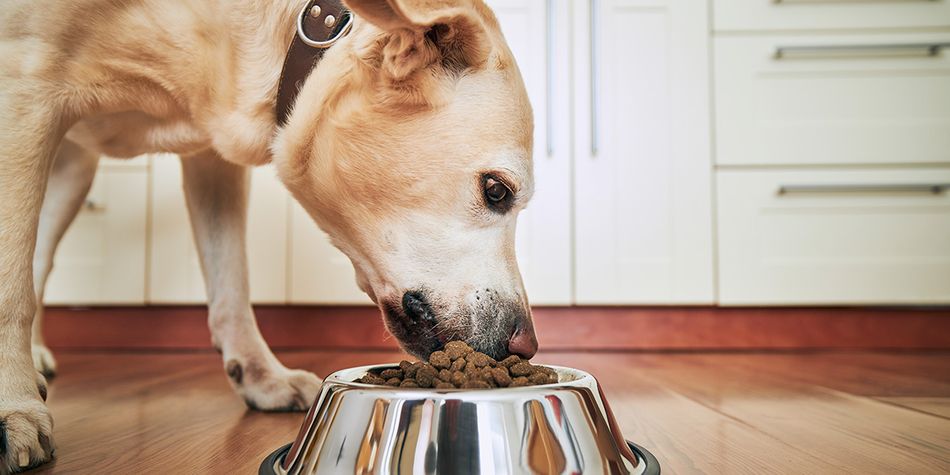5 top tips for walking your dog safely in bad weather

British weather is notoriously unpredictable. When it takes a turn for the worse, keeping yourself and your dog safe on walks is a top priority.
Rain, snow and icy conditions can all pose risks, but with the right precautions, you and your furry friend can still enjoy your outings.
With help from Ryan Neile, Head of Behaviour Services at the Blue Cross, we bring you expert advice on how to keep your dog safe and comfortable in bad weather, including tips to help you recognise when your dog is too cold, and ways to keep your pet active and entertained indoors.
1. Make sure you're both visible

Shorter days and overcast skies can make it harder for drivers and cyclists to see you and your dog. Stick to well-lit routes, where possible. If it helps, carry a torch - and we've tested the best AA and AAA batteries to help keep it working all winter.
Reflective gear, such as high-visibility jackets and clip-on lights can also help ensure you’re both seen. Additionally, you can make sure your dog is more visible by buying an LED collar.
'LED or reflective collars and harnesses will make it easy for you and others to see your dog, so these are great things to invest in,' says Ryan.
Compare popular models and learn the differences between back and front clip harnesses in our guide to the best dog harnesses
2. Pay attention to their body language

Dogs communicate their discomfort through body language. If your dog is shivering, lifting their paws frequently, or showing reluctance to walk, it may be too cold or wet for them. Watch for signs of distress and be prepared to cut your walk short if needed.
'Dogs can show us they are scared or uncomfortable in many different ways, ranging from tucking their tails between their back legs, crouching low to the ground, shivering, panting or licking their lips. They might stop still and resist going towards something they are not sure about, or even pull away in the opposite direction,' says Ryan.
'If you are seeing these things in your dog regularly, and it contrasts with how they normally behave when they are happy and relaxed, speak to your vet who will check their health first. If appropriate, they will put you in touch with a qualified animal behaviourist.'
The best UK walks this winter: We reveal walking routes near you that are ideal for scenery, wildlife and peace and quiet
3. Invest in a dog coat and boots

Certain dog breeds, especially short-haired or small dogs, struggle to retain their body heat in wet and cold conditions. A waterproof dog coat or jumper can help keep them warm and dry, while boots can protect their paws from icy surfaces, road salt, and sharp debris.
'If your dog starts lifting their paws, whining or stopping while out on walks it could be because their feet are too cold. Getting some doggy winter boots for them to wear can be a good way to help protect their paws,' says Ryan. 'Look for booties that have a good sole and Velcro straps.'
It's important not to rush your dog into wearing anything they're not used to wearing. Ryan advises: 'Most dogs will need a gentle introduction to wearing boots, so try them slowly in the house at first for short periods at a time. Remember, if your dog doesn’t like wearing boots, do not force them.'
Keeping your dog dry and warm is one thing, but make sure you're dressing yourself appropriately too. Don't miss our guides on the best walking boots, walking trousers and waterproof jackets before your next rainy ramble.
Take additional care when walking in frosty conditions. See our advice on getting around safely on snow and ice
4. Wipe down after walks

Snow, ice, and grit from pavements can irritate and even injure your dog’s paws, so it's important to clean them off after every walk.
Wipe down their paws with a warm, damp cloth to remove any residue, making sure to check between their toes for leftover debris. Keeping their paws clean also prevents them from licking harmful substances like road salt and de-icer, which can be toxic to dogs in small amounts and might not be obviously present.
Muddy pawprints covering your house? Use one of the best cleaning sprays or carpet stain removers to banish them quickly, or mop up larger messes with a Best Buy carpet cleaner or handheld vacuum cleaner.
5. Practice recall and look out for hazards

Winter weather can create additional hazards, from hidden potholes to frozen ponds. Don’t let your dog near bodies of water when out walking, especially frozen lakes or rivers. If they were to fall in, it could be life-threatening in cold conditions. Keep them on a lead near roads or in unfamiliar areas to avoid accidents.
'Dogs see much better in the dark than us, but owners might feel safer walking in well-lit areas during the darker winter months so they can avoid hazards they can’t see well,' says Ryan. 'Always ensure collars, leads and harnesses are suitably sized, correctly fitted and are in good working order to prevent your dog breaking free and running away.
'Most importantly of all, make sure your dog has a strong recall, so if off lead (day or night, summer or winter) you can reliably call them to you to get them safely back under control in an emergency.'
We surveyed 1,300 pet owners in the UK and analysed over 300 policies to bring you the best pet insurance providers
When is it too cold to walk your dog?

As a general rule, if it’s too cold for you, it’s likely too cold for your dog. Though some dogs, like huskies and malamutes, will have a greater resistance to (and may even enjoy) colder weather, many breeds are more vulnerable and require extra care in low temperatures.
Most dogs can handle temperatures down to around 7°C without issue. Between 0 and 7°C, some - such as elderly or short-haired breeds - may start to feel uncomfortable. Anything below freezing can become dangerous for dogs, particularly if they are exposed to cold temperatures for prolonged periods.
'Pay attention to local weather forecasts and consider that most hazard warnings for people will also apply to dogs, so be sensible and take the recommended precautions,' says Ryan. 'Thunderstorms and strong winds can scare some dogs so it’s best to avoid walking during these times, or if bad weather is forecast imminently.'
Wind chill and damp conditions can make it feel even colder, so always assess the weather before heading out.
How to exercise your dog if the weather is too bad outside

If the conditions are too extreme for a walk, there are plenty of ways to keep your dog active indoors.
'Skipping the odd walk because of bad weather isn’t something to worry about.
'Of course they will need to go outside for the loo, but in place of your regular walk you can swap physical exercise (which is great for your dog’s health and heart) for mental exercise and stimulation (great for your dog’s brain),' says Ryan.
'Flick treats for them to chase, or hide them in different areas of your home so that they have to use their noses to track and find them.
'There are plenty of toys available to buy that are designed for food to be packed inside them making it challenging for dogs to get to. The concentration and focus required to get the food out of the toy is mentally tiring and also very rewarding, so this type of activity is a great alternative to a normal walk.
'All dogs will benefit hugely from a combination of both physical and mental exercise and the variety it will add to their lives.'
Best gifts for dogs – affordable toys, harnesses, treats and more
With thanks to the Blue Cross for the expert advice provided in this article.
For more expert pet advice or to make a donation to help national pet charity Blue Cross help more sick, injured and homeless animals visit bluecross.org.uk




